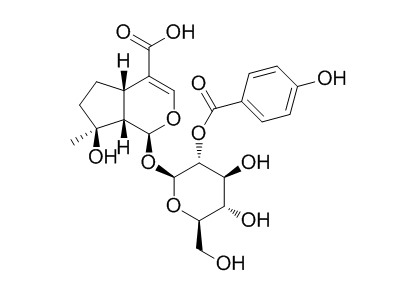Negundoside
Negundoside exerts a protective effect on CYP2E1-dependent CCl4 toxicity via inhibition of lipid peroxidation,followed by an improved intracellular calcium homeostasis and inhibition of Ca2+-dependent proteases. Negundoside causes a stimulatory effect on P-glycoprotein (P-gp).
Inquire / Order:
manager@chemfaces.com
Technical Inquiries:
service@chemfaces.com
Tel:
+86-27-84237783
Fax:
+86-27-84254680
Address:
1 Building, No. 83, CheCheng Rd., Wuhan Economic and Technological Development Zone, Wuhan, Hubei 430056, PRC
Providing storage is as stated on the product vial and the vial is kept tightly sealed, the product can be stored for up to
24 months(2-8C).
Wherever possible, you should prepare and use solutions on the same day. However, if you need to make up stock solutions in advance, we recommend that you store the solution as aliquots in tightly sealed vials at -20C. Generally, these will be useable for up to two weeks. Before use, and prior to opening the vial we recommend that you allow your product to equilibrate to room temperature for at least 1 hour.
Need more advice on solubility, usage and handling? Please email to: service@chemfaces.com
The packaging of the product may have turned upside down during transportation, resulting in the natural compounds adhering to the neck or cap of the vial. take the vial out of its packaging and gently shake to let the compounds fall to the bottom of the vial. for liquid products, centrifuge at 200-500 RPM to gather the liquid at the bottom of the vial. try to avoid loss or contamination during handling.
New Journal of Chemistry2019, 43:12538-12547
Korean J. Medicinal Crop Sci.2022, 30(2):117-123.
J.Korean Society of Grassland&Forage Science2023, 43(3):138-147.
J Nat Med.2017, 71(4):745-756
Molecules.2019, 24(2):E343
Int J Mol Sci.2020, 21(9):3239.
Phytomedicine.2015, 22(11):1027-36
Anal Biochem.2019, 569:10-15
Nutrients.2020, 12(12):3638.
Neuroscience.2024, 559:77-90.
Related and Featured Products
WORLD JOURNAL OF GASTROENTEROLOGY,2008, 14(23).
Negundoside,an irridiod glycoside from leaves of Vitex negundo,protects human liver cells against calcium-mediated toxicity induced by carbon tetrachloride.[Reference:
WebLink]
To evaluate the protective effect of 2'-p-hydroxy benzoylmussaenosidic acid [Negundoside(NG) ,against carbon tetrachloride(CCl4) -induced toxicity in HuH-7 cells.
METHODS AND RESULTS:
CCl4 is a well characterized hepatotoxin,and inducer of cytochrome P450 2E1(CYP2E1) -mediated oxidative stress. In addition,lipid peroxidation and accumulation of intracellular calcium are important steps in the pathway involved in CCl4 toxicity. Liver cells(HuH-7) were treated with CCl4,and the mechanism of the cytoprotective effect of NG was assessed. Silymarin,a known hepatoprotective drug,was used as control. NG protected HuH-7 cells against CCl4 toxicity and loss of viability without modulating CYP2E1 activity. Prevention of CCl4 toxicity was associated with a reduction in oxidative damage as reflected by decreased generation of reactive oxygen species(ROS) ,a decrease in lipid peroxidation and accumulation of intracellular Ca2+ levels and maintenance of intracellular glutathione homeostasis. Decreased mitochondrial membranepotential(MMP) ,induction of caspases mediated DNA fragmentation and cell cycle arrest,as a result of CCl4 treatment,were also blocked by NG. The protection afforded by NG seemed to be mediated by activation of cyclic adenosine monophosphate(cAMP) synthesis and inhibition of phospholipases(cPLA2) .
CONCLUSIONS:
NG exerts a protective effect on CYP2E1-dependent CCl4 toxicity via inhibition of lipid peroxidation,followed by an improved intracellular calcium homeostasis and inhibition of Ca2+-dependent proteases.
Phytotherapy research, 2010, 24(3):454-458.
Modulation of P-glycoprotein ATPase activity by some phytoconstituents.[Reference:
WebLink]
METHODS AND RESULTS:
In the present investigation 16 phytoconstituents, which are active moieties found in several medicinal herbs, have been evaluated for their P-glycoprotein (P-gp) stimulation/inhibition profiles using a P-gp-dependent ATPase assay in rat jejunal membrane (in vitro). Acteoside, agnuside, catechin, chlorogenic acid, picroside -II and santonin showed an inhibitory effect. Negundoside, picroside -I and oleanolic acid caused a stimulatory effect. Andrographolide, apocyanin, berberine, glycyrrhizin, magniferin and piperine produced a biphasic response (stimulation at low concentration and inhibition at high concentration).
CONCLUSIONS:
The results suggested that a possible interaction of these phytoconstituents at the level of P-gp, could be an important parameter in determining their role in several key pharmacodynamic events.
Acta chromatographica, 2009, 22(3):225-228.
Quantification of negundoside in Vitex negundo Linn. Leaf by high-performance thin-layer chromatography.[Reference:
WebLink]
An HPLC method has been developed for routine analysis of Negundoside in Vitex negundo Linn. leaf extract.
METHODS AND RESULTS:
Separation was performed on a C 18 column with 65:35 ( v / v ) buffer solution (containing 0.01 M potassium dihydrogen orthophosphate and 0.01 M heptane sulphonic acid sodium salt; pH 3.0)-methanol as mobile phase. Detection and quantification were achieved by use of UV and photo diode array detectors operated at 251 nm. Response was a linear function of Negundoside concentration in the range 1-37.5 μg mL -1 (correlation coefficient 0.9996).
CONCLUSIONS:
The method was validated for system and method precision, accuracy, linearity, and solution stability. The method is sensitive, simple, rapid, accurate, and precise and can therefore be used for routine qualitycontrol analysis of Vitex negundo Linn. leaf powder, including quantitative analysis of Negundoside.



